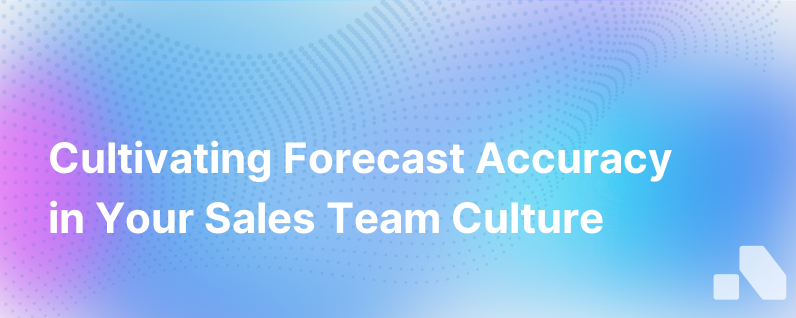Tips For Building A Culture Of Forecast Accuracy
Published on September 28, 2023 by David Zhang
Building a culture of forecast accuracy is no small feat, but it’s a vital one, offering numerous benefits, including better-informed business decisions, more effective resource allocation, and enhanced investor confidence. In the complex realm of B2B sales, where sales cycles are often longer and involve multiple stakeholders, forecasting becomes both more challenging and more critical. In this guide, we will explore the steps organizations can take to build a culture where accurate sales forecasting is valued and achieved.
Understanding Forecast Accuracy
Forecast accuracy sits at the nexus of data analytics and human judgment. Accurate forecasts provide visibility into future revenues, enabling organizations to plan effectively for growth, manage cash flow, and steer strategic decision-making. It’s not about predicting the future with absolute certainty—it's about creating reliable data that consistently gives you the best understanding of what the future might hold.
The Foundations of Forecast Accuracy
At the heart of forecast accuracy is the data – both qualitative and quantitative – that fuels predictive insights. Data needs to be comprehensive, current, and clean. Beyond data, there are cultural, process, and technology factors at play. Let’s explore these elements in greater depth:
Encouraging a Data-driven Culture
-
Leadership Buy-in: Leaders at all levels must advocate for the importance of forecast accuracy. Executive sponsorship sets the tone, establishing forecast accuracy as a key priority and value.
-
Transparent Communication: Teams should understand why forecasts are essential, how they’re used by the company, and how everyone contributes to accuracy. Communication around these points encourages buy-in and responsibility.
-
Training and Development: Provide regular training on data input, analysis, and forecasting methods. The more skilled your team is, the better the data quality and the accuracy of the forecasts.
-
Accountability: Establish clear expectations and accountability structures. Team members should be held responsible for the accuracy and timeliness of their input.
Refining Process and Methodology
-
Standardize Processes: Solidify your sales process with clearly defined stages and criteria. A standardized process ensures everyone assesses opportunities the same way.
-
Frequent Re-forecasting: The market and individual deals are always changing. Encourage a cadence of frequent reforecasting that reflects the current reality of the sales pipeline.
-
Historical Analysis: Regularly compare previous forecasts to actual outcomes to learn from discrepancies.
-
Bias Mitigation: Teach teams to recognize and minimize cognitive biases, such as overconfidence or anchoring, which can skew forecasts.
-
Collaborative Forecasting: Involve a cross-functional team in the forecasting process to leverage diverse expertise and viewpoints, which can sharpen the accuracy.
Leveraging Technology
-
CRM Platform: A robust CRM platform is the backbone of accurate forecasting. It should capture all customer interactions, transactions, and movements through the sales funnel in real-time.
-
Automated Data Entry: Reduce human errors by automating as much data entry as possible. Integration between systems can also ensure that data is consistent and up-to-date across platforms.
-
AI and Machine Learning: Employ advanced algorithms, predictive analytics, and machine learning to provide deeper insights and to augment the human element of forecasting.
Practical Tips for Cultivating Forecast Accuracy
Here we delve into specific actions that can create a robust environment for forecast accuracy:
-
Reward Accuracy Over Optimism: Rather than rewarding the most optimistic forecasts, incentivize accuracy. Celebrate the teams or individuals who consistently deliver precise forecasts.
-
Implement a Rolling Forecast Approach: Replace or supplement traditional annual forecasts with a rolling approach that updates forecasts regularly to reflect new information.
-
De-Silo Data: Ensure that crucial data flows freely between departments. Siloed information can lead to incomplete analysis and flawed forecasts.
-
Model Different Scenarios: Use scenario planning to understand the potential outcomes of different market conditions and business decisions on your forecasts.
-
Invest in Skills Training: Help your team build the necessary data analysis and critical thinking skills through regular training and professional development.
-
Focus on Lead Quality: Train sales teams to focus on lead quality over quantity. Better leads produce a more accurate understanding of the pipeline and potential revenue.
-
Prioritize Pipeline Hygiene: Maintain a clean pipeline by removing dead or stalled opportunities, which can give a false sense of security and lead to inaccurate forecasts.
-
Conduct Win/Loss Reviews: Use these insights to understand patterns in selling processes and potential forecast inaccuracies.
-
Leverage Post-Mortem Analyses: When forecasts miss the mark, conduct post-mortem analyses to identify why and learn from the discrepancies.
-
Foster a No-Blame Environment: Create a culture where reporting bad news is not penalized. Accurate bad news is better than inaccurate good news.
-
Use Granular Metrics: Utilize detailed key performance indicators (KPIs) at each stage of the sales cycle to better understand where forecasts may be going off track.
-
Integrate Financial and Sales Planning: Ensure that sales forecasts are closely aligned with broader financial planning.
-
Invite Constructive Critiques: Encourage the constructive challenge of forecasts to ensure all angles have been considered, and groupthink is avoided.
Conclusion
Creating a culture of forecast accuracy is not an overnight process; it takes thoughtful investment in people, processes, and technology. Commitment across the organization, from leadership to the sales team, is crucial. As with any cultural change, persistence and consistency in driving these best practices, along with a willingness to learn, adapt, and invest in necessary tools and training, will yield a culture where accurate sales forecasting is the norm, not the exception.
In our digital era, platforms such as Aomni can streamline the journey toward forecast accuracy, enabling seamless capture of critical data and offering AI-powered insights into buyer behavior and sales probabilities. By embracing such tools while instilling the principles and tips discussed, any organization can cultivate this invaluable culture of forecast accuracy.